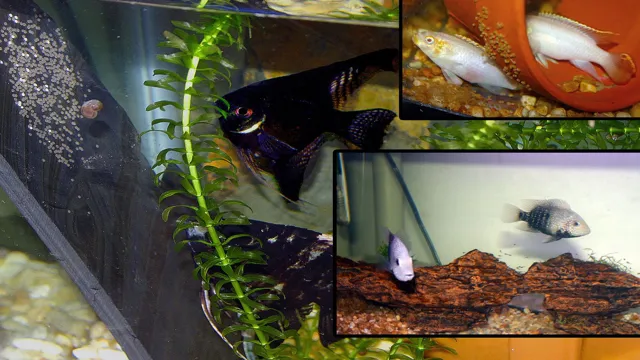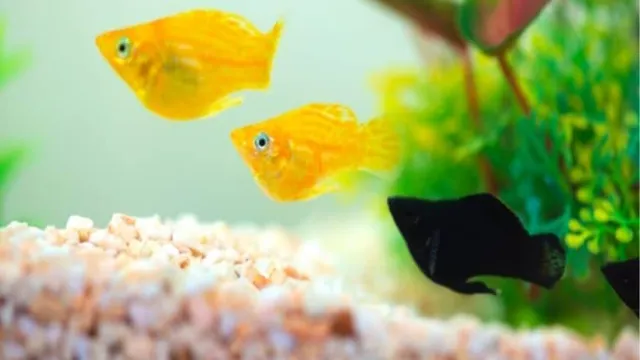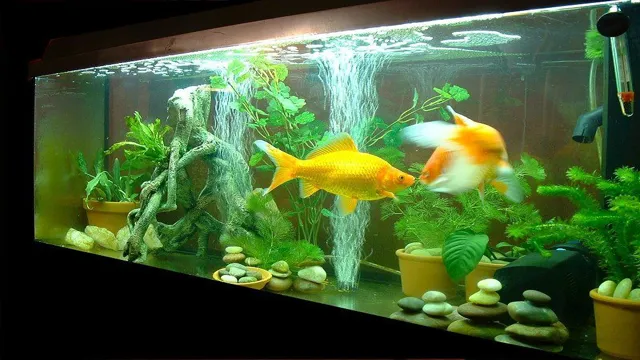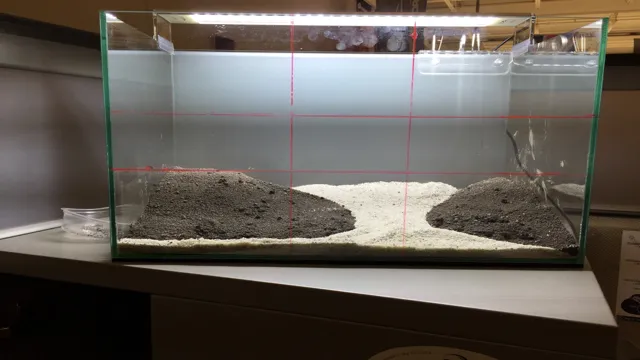Looking for a hobby that will add a splash of color and life to your home? Why not try breeding aquarium fish at home? It’s a fun and rewarding activity that can be enjoyed by people of all ages. Not only is it a great way to beautify your living space, but it also offers a unique opportunity to observe and learn about these fascinating creatures. Breeding aquarium fish is easy, but it does require a bit of knowledge, effort, and patience.
You’ll need to choose the right species, set up a suitable tank, and provide proper care and nutrition. But once you get the hang of it, you’ll be hooked! One of the great things about breeding aquarium fish is the vast variety of species to choose from. Whether you want guppies, tetras, cichlids, or bettas, there’s a fish out there for you.
And with so many colors, patterns, and behaviors to explore, you’ll never get bored. But breeding aquarium fish isn’t just about aesthetics. It’s also an educational experience that teaches us about the delicate balance of nature and the importance of conservation.
By breeding fish responsibly and sharing our knowledge with others, we can help preserve these beautiful creatures for generations to come. So why not give it a try? With a little bit of effort, you can turn your home into a vibrant aquatic paradise and enjoy the many benefits of breeding aquarium fish.
Preparing for Breeding
Breeding aquarium fish at home can be a rewarding experience for fish enthusiasts. But before diving right into breeding, it’s important to prepare and ensure the right conditions for your fish. Make sure your aquarium is large enough for your breeding pair and has plenty of hiding spots for the fish.
Set up a separate tank for the fry and equip it with a heater and filter. Research the specific breeding requirements for your fish species, including water temperature, pH levels, and diet. Some fish species may require a different diet during breeding, so it’s important to have the right food prepared.
Finally, monitor your fish closely during the breeding process and be prepared for the possibility of aggression towards the female or fry. With proper preparation and care, breeding aquarium fish at home can be a successful and rewarding experience.
Setting up the Tank
When it comes to breeding fish, setting up the tank is a crucial step. In order to ensure the success of breeding, there are a few things to keep in mind. First and foremost, the tank needs to be properly cleaned and prepared for the breeding process.
This means removing any debris or waste from the tank, checking the water levels, and adding any necessary chemicals or treatments to ensure the water is safe for breeding. Additionally, it’s important to create proper hiding places and structures within the tank for the fish to lay their eggs. This can be achieved by adding plants, rocks, or other decorations.
Lastly, it’s important to choose the right type and number of fish for breeding. Research the types of fish you’re interested in breeding and ensure that they are compatible and will thrive in the tank environment you’ve created. By taking these steps, you can increase your chances of success in breeding your desired fish species.

Choosing your Fish
When selecting fish for breeding purposes, it’s important to consider several factors to ensure the best possible outcome. Firstly, you should decide on the specific species of fish you want to breed and make sure they are compatible with each other. You should also consider the conditions required for breeding and ensure that the tank is of adequate size and quality.
Another important factor is the age and health of the fish you choose, with younger, healthier fish typically being the best candidates for breeding. It is also important to note that certain fish may have specific breeding requirements, such as temperature or water pH levels. By taking these factors into consideration, you can increase your chances of successfully breeding your chosen species and producing healthy offspring. (See Also: How to Get Freshwater for Aquarium: A Comprehensive Guide)
Breeding Process
Breeding aquarium fish at home can be an incredibly rewarding experience for any fish enthusiast. The process of breeding aquarium fish can vary depending on the species, but generally involves a few key steps. Before attempting to breed your fish, it’s important to make sure that your aquarium is set up properly with the right conditions and equipment.
Once your aquarium is ready, you’ll need to carefully select the right breeding pair of fish, ensuring that they are healthy and have compatible temperaments. From there, it’s important to create a suitable environment for the fish to breed in by replicating their natural habitat as closely as possible. This can involve adding plants, rocks, or other decorations to the aquarium.
Finally, it’s a waiting game as you watch for signs of breeding activity, such as the fish building a nest or laying eggs. By following these steps and providing proper care during the breeding process, you can successfully breed aquarium fish at home and enjoy the sight of new life in your aquarium.
Creating the Right Environment
When it comes to breeding, creating the right environment is crucial for the success of the process. The environment should be suitable to promote the physical and emotional well-being of the animals involved. The right environment will ensure that they are comfortable, healthy, and happy, which is necessary for successful breeding.
Additionally, the environment should be free from stressors that may affect the breeding process negatively. The animals should be provided with the ideal conditions for mating, such as the right temperature, lighting, and comfortable bedding. Furthermore, it would be beneficial to provide the animals with a balanced diet and adequate hydration to keep their bodies in top shape.
A healthy and conducive environment will significantly increase the chances of successful breeding, which is the ultimate goal. Therefore, ensuring that the right environment is in place should be a top priority for any breeder.
Feeding and Care
Breeding Process Breeding hedgehogs can be a fun and rewarding experience as long as you understand the process and are dedicated to providing the right care for your new arrivals. The first step in the breeding process is to ensure that the hedgehogs you intend to breed are healthy and free of any genetic defects. Once you have confirmed that your hedgehogs are suitable for breeding, you will need to provide them with the right environment to mate.
This involves creating a comfortable and welcoming space that is large enough for both hedgehogs to move around freely but is also secure enough to prevent any escape attempts. It’s important to remember that hedgehogs can be very territorial animals and may not always get along with one another. Therefore, it’s essential to introduce the hedgehogs slowly and carefully to avoid any conflicts that could lead to injury.
Once the hedgehogs have mated, the female will go through a gestation period of around 30-40 days, after which she will give birth to a litter of between two and six hoglets. During this time, it’s important to monitor the mother and her babies closely to ensure that they are healthy and thriving. This includes providing the mother with a nutrient-rich diet to help her produce milk for her young.
It’s also crucial to keep the environment clean and free of any potential bacterial or fungal infections that could harm the newborns. Overall, breeding hedgehogs can be a fun and exciting experience, but it’s essential to understand the process and dedicate the necessary time and care towards providing a healthy and safe environment for the hedgehogs and their offspring.
Understanding the Breeding Cycle
Breeding a pet is a complex process that requires careful consideration and planning. The breeding cycle typically begins with the female experiencing her fertile period, which varies depending on the species. During this time, the female will release eggs, which can be fertilized by a male’s sperm. (See Also: How to Clear Up a Cloudy Fish Aquarium in 5 Simple Steps – A Comprehensive Guide)
The pair will typically mate multiple times during this period to increase the chances of fertilization. After a successful mating, the fertilized eggs will begin to develop, and if all goes well, the female will give birth to offspring several weeks later. However, it’s important to note that breeding should only be done under the guidance of a veterinarian or an experienced breeder, as it can carry certain risks and complications.
Additionally, it’s crucial to ensure that both the male and female are healthy and free of any underlying genetic conditions that could be passed down to their offspring. By taking the necessary precautions and being fully informed about the breeding process, pet owners can ensure a successful and healthy breeding cycle for their furry friends.
Raising the Fry
Breeding aquarium fish at home can be a rewarding yet challenging hobby. One of the most exciting parts is raising the tiny fry once they hatch. The key to success is providing the right environment and nutrition for the newborn fish.
Depending on the species, some fry may require special care, such as live food or frequent water changes. It’s important to research the specific needs of your species and prepare accordingly. Maintaining proper water quality and temperature is also crucial for the fry’s survival.
As they grow, you can gradually introduce them to larger tanks and different types of food. With patience and dedication, raising fry can be a fun and rewarding experience for any aquarist.
Separating Fry from Adults
When it comes to raising fry, it’s crucial to separate them from the adult fish in the tank. Not only do they have different dietary needs, but adult fish may also see the fry as a potential meal. To give your fry the best chance of survival, consider using a breeding net or separate tank to house them.
This will also make it easier to monitor their growth and adjust their feeding schedule as needed. Remember to feed them small amounts frequently throughout the day and use specialized fry food to ensure they get the nutrients they need to thrive. With proper care and attention, your fry will grow into healthy adult fish ready to join the rest of the tank.
Feeding Fry
When raising fry, providing them with adequate nutrition is crucial for their growth and development. In the early stages of their life, fry feed mostly on infusoria and other microscopic organisms present in the water. As they grow, they require more substantial food sources such as baby brine shrimp, micro worms, and commercial fry food.
It’s important to offer frequent feedings throughout the day, as they have small stomachs and can quickly become undernourished. One useful tip is to divide the total amount of food into smaller portions and feed them at intervals throughout the day. Additionally, keeping the water clean and maintaining good water quality also plays an important role in their growth and development.
By following these tips, you can help ensure the health and wellbeing of your fry, setting them up for success in their future as adult fish.
Conclusion and Next Steps
In conclusion, breeding aquarium fish at home can be a rewarding and fulfilling experience. It not only allows you to bring new life into your aquarium, but it also creates a sense of achievement and pride as you nurture and witness the growth of your fish. Remember to research and understand the specific needs of your fish species, as well as provide them with a comfortable and healthy environment. (See Also: What is the Use of Bio Balls in Aquarium? Benefits of Using Bio Balls for Effective Filtration)
And who knows, with some skill and luck, you may even be able to create your own unique, one-of-a-kind fish species. So venture forth, fish guardians, and let the breeding begin!”
FAQs
What kind of fish are suitable for breeding in an aquarium at home?
Fish like guppies, bettas, mollies, and platies are suitable for breeding in an aquarium at home.
Can aquarium fish breed without any specialized equipment?
Yes, in most cases, breeding aquarium fish does not require specialized equipment. However, a separate breeding tank and adequate food and water conditions may be necessary.
How long does it take for aquarium fish to breed?
The breeding time can vary depending on the fish species, but it typically takes about 2-4 weeks for eggs to hatch after fertilization.
Do aquarium fish need to be separated for breeding?
Yes, it’s essential to separate male and female fish to avoid aggression and ensure successful breeding.
What are the necessary conditions for breeding aquarium fish at home?
The necessary conditions for breeding aquarium fish include maintaining a stable water temperature, providing high-quality food, and keeping the water clean and oxygenated.
How can you tell if your aquarium fish are ready to breed?
Hiding behavior, courtship rituals, and visible reproductive organs are signs that aquarium fish are ready for breeding.
What should you do with the fry (baby fish) after breeding aquarium fish at home?
You should move the fry to a different tank and provide specialized food until they grow and mature enough to be moved to a regular fish tank.







